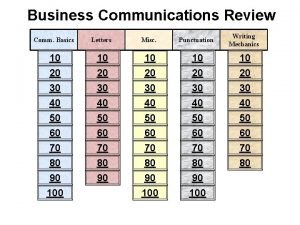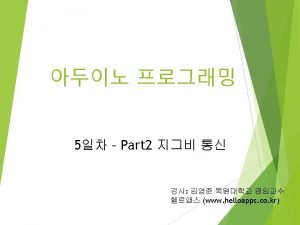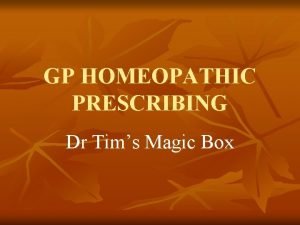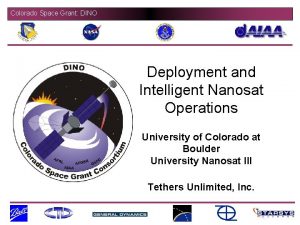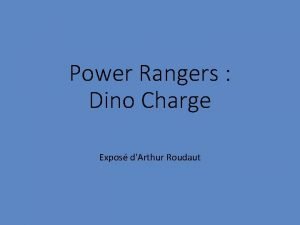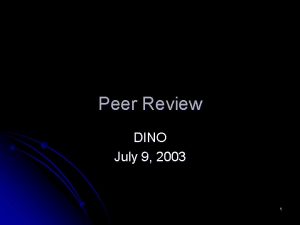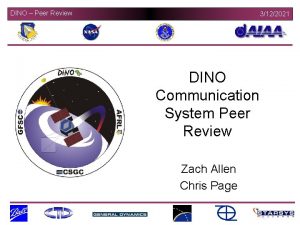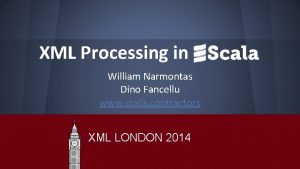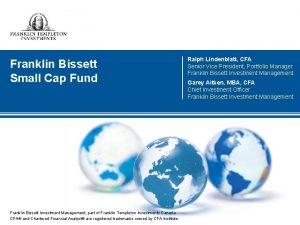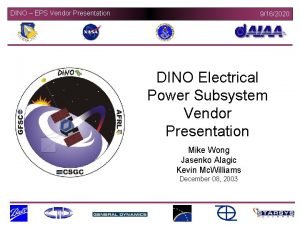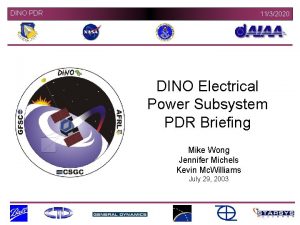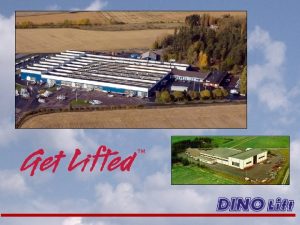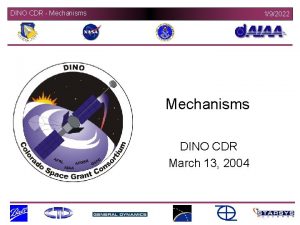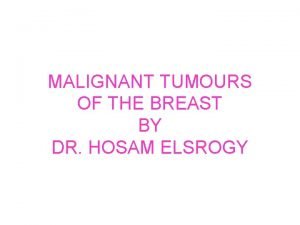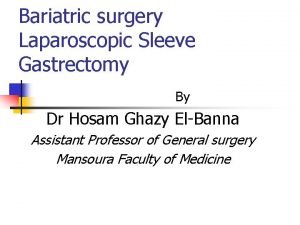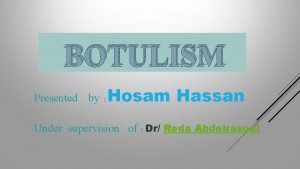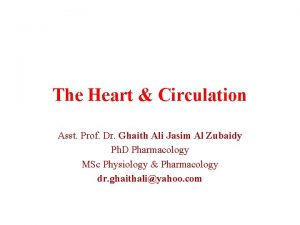DINO Safety Review DINO Communications Team Hosam Ghaith


















- Slides: 18

DINO Safety Review DINO Communications Team: Hosam Ghaith Mike Li Zach Allen Colorado Space Grant 1

Bonding and Grounding n n n Satellite Structure must be bonded to the ICU chassis ground to prevent charge accumulation Resistance between any payload point and the Orbiter must be less than 1 Ohm. Bonding can be achieved by metal-to-metal contact, or by conductive coating and surface treatments. Colorado Space Grant 2

Example n n Calculate the total resistance between points A and B. Worst case scenario: the two 0. 0025 Ohm resistors are not grounded, and total resistance is 0. 810 Ohms (less than 1). Colorado Space Grant 3

Different Bonding Methods n n Alodine or chemical conversion: helps to prevent corrosion and, thus, strengthens bonds. Bare metal to metal contact guarantees conductivity Bonding strap: conductive and also secure bonding Anodizing both parts is NOT a good bonding method: results in insulation, not conductivity. Colorado Space Grant 4

Grounding n Core ICD document 10. 7. 4. 1 and 10. 7. 4. 3 states that “the Orbiter D. C. power return from a Cargo element shall be … D. C. isolated from structure ground in the Cargo element by a minimum of 1 Mega Ohm. ” Colorado Space Grant 5

Example n The following scheme does not satisfy the requirement: need an extra 1 MΩ resistor between ground and negative side of battery Colorado Space Grant 6

SIP n n n The resistance between any point on the Nanosat and the satellite interface panel (SIP) must always be less than 2. 5 milli Ohms. Why? To prevent excessive heating or thermal dissipation To prevent static build-up (which may damage some parts). Colorado Space Grant 7

Fault-Tolerance (Fixed Antenna) n Electrical inhibits (interruption feature) are not necessary q q No mechanical/pyrotechnic functions Fuses? Colorado Space Grant 8

Fault-Tolerance (Deployable Antenna) n Accidental deployment prevention q q q Premature deployment could affect Orbiter operation (Catastrophic Hazard)1 Minimum of 3 independent inhibits (2 fault tolerant)2 Need one independently controlled inhibit in the ground return path 3 1. 2. 3. 202. 4 – “SPECIFIC CATASTROPHIC HAZARDOUS FUNCTIONS: Planned Deployment/Extension Functions ” 201. 3 – “must be controlled by a minimum of three independent inhibits” 201. 3 – “the ground return for the function circuit must be interrupted by one of the independent inhibits” 4. Section numbers refer to NSTS 1700. 7 B Colorado Space Grant 9

Power Concerns n COMM system meets Unpowered Bus Exception 1 q q COMM might have catastrophic hazards System is de-energized prior to payload deployment Relay 1 Relay 2 Battery Satellite Subsystem Critical Hazard Satellite System Catastrophic Hazard Relay 3 1. 2. 201. 1 c(3): Unpowered Bus Exception Section numbers refer to NSTS 1700. 7 B Colorado Space Grant 10

Question 14: Nanosat Power System Inhibit 1 Inhibit 2 Inhibit 3 Deployable Antenna Solar array RF System Inhibit 4 Colorado Space Grant 11

Safety Exam, Question 14 n Two extra independent inhibits needed: q q n n 1 inhibit between the solar panel positive output and battery. 1 inhibit in solar array ground return path, between solar array and battery. Inhibits do not need to be monitored for RF system because it is not more that 6 d. B over ICD limits. Inhibits need to be monitored since only 3 between battery and antenna mechanism Colorado Space Grant 12

Transmissions n Two types of transmissions q Cargo Bay Doors Closed n q Max. intentional radiated field of 0. 5 V/m 1 Cargo Bay Doors Open n Payload to orbiter limit of 4 V/m 2 1. ICD 2 -19001 section 10. 7. 3. 2. 2. 2. 1 2. ICD 2 -19001 diagram 10. 7. 3. 2. 2. 2. 1. 2 -1 Colorado Space Grant 13

Diagram 10. 7. 3. 2. 2. 2. 1. 2 -1: Payload to Orbiter Field Limit Colorado Space Grant 14

RF Power Levels n NSTS 1700. 2 B section 202. 5 d: q n “For payload transmitters in the payload bay or crew cabin, three independent inhibits are required whenever the intentional radiation would exceed the ICD limits and is assessed as hazardous. ” NSTS 1700. 2 B section 202. 5 e: q “RF transmitter inhibits do not require monitoring unless the radiation levels would exceed the ICD allowable levels by more than 6 d. B in which case two of three inhibits must be monitored. “ Colorado Space Grant 15

Potential Interference with STS Communications n 919 Communication Channels q Channel 1 through 801 (STDN) n q Channel 850 through 882 (NASA DSN Deep Space Network) n Colorado Space Grant Receive Frequencies 2200 MHz to 2300 MHz Receive Frequencies 2290. 185185 MHz to 2299. 814815 MHz 16

Potential Interference with STS Communications n Channel 900 through 919 (DOD/SGLS) q n Closest Potential frequency: Tip Mass Wireless Ethernet Transmitter q n 2202. 500 MHz to 2297. 500 MHz 2412 MHz to 2462 MHz DSSS (Direct Sequence Spread Spectrum) Close to 6 th harmonic of 400 MHz Ham Band Colorado Space Grant 17

Conclusion n Communication Subsystem will probably have at least one catastrophic hazard q q n Deployable Antenna Transmit Power? Will not know if hazard is critical or catastrophic until Communication System is designed further Colorado Space Grant 18
 Business communications review
Business communications review Bureaucratic bypass syndrome
Bureaucratic bypass syndrome Team spirit becomes team infatuation
Team spirit becomes team infatuation The white team cheers for the blue team, just like
The white team cheers for the blue team, just like Dino žanetić
Dino žanetić Lucio predonzani
Lucio predonzani Résumé chasseurs de vieux
Résumé chasseurs de vieux Digi xctu
Digi xctu Creating a dinosaur sculpture step by step
Creating a dinosaur sculpture step by step Dr tims dino treatment
Dr tims dino treatment Grant dino
Grant dino Zordle
Zordle Ss dino uplink
Ss dino uplink Dino zrilic
Dino zrilic Struktur organisasi tokopedia
Struktur organisasi tokopedia Alket dino
Alket dino Dino box communication device
Dino box communication device Dino fancellu
Dino fancellu Franklin bissett sma
Franklin bissett sma
